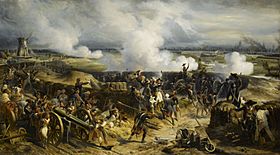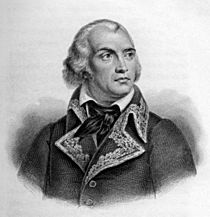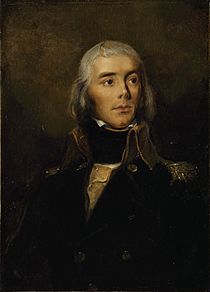Siege of Ypres (1794) facts for kids
Quick facts for kids Siege of Ypres (1794) |
|||||||
|---|---|---|---|---|---|---|---|
| Part of War of the First Coalition | |||||||
 Capture of Ypres, 17 June 1794 by Henri Félix Emmanuel Philippoteaux (Musée de la Révolution française) |
|||||||
|
|||||||
| Belligerents | |||||||
| Commanders and leaders | |||||||
| Units involved | |||||||
| Army of the North | Clerfayt's Corps | ||||||
| Strength | |||||||
| Total: 50,000 Roeselare: 20,000 Hooglede: 24,000 |
Ypres: 7,000 Roeselare: 20,000 Hooglede: 19,000 |
||||||
| Casualties and losses | |||||||
| Ypres: unknown Roeselare: 1,000 Hooglede: 1,300, 1 gun |
Ypres: 7,000, 12 guns Roeselare: 1,000 Hooglede: 900 |
||||||
The Siege of Ypres (June 1–18, 1794) was an important battle during the War of the First Coalition. This war was part of the larger Wars of the French Revolution. A French army, led by Jean-Charles Pichegru, surrounded the city of Ypres.
Ypres was a strong fortress defended by 7,000 soldiers from Austria and Hesse. While the French attacked the city, other French troops under Joseph Souham stopped three attempts by an Austrian army to rescue Ypres. Eventually, the French, led by Jean Victor Marie Moreau, forced the city's defenders to give up.
In 1794, Ypres was part of the Austrian Netherlands. Today, it is a town in Belgium, located about 120 kilometres (75 mi) west of Brussels.
Contents
Why the Siege Happened
In 1794, the war in the Flanders region was heating up. The Coalition army, made up of different countries, tried to attack the French in the middle. But the French decided to attack on the sides instead.
The Coalition had some early success. However, the French quickly took control by attacking again and again. When the Coalition moved their troops to defend the Sambre River, the French army, led by Pichegru, saw an opportunity. They began to surround Ypres.
The Austrian army, led by François Sébastien Charles Joseph de Croix, Count of Clerfayt, was too small to defend the western side. A week after Ypres fell, the French won another big battle at Fleurus.
Armies and Plans
In March 1794, France's Army of the North had about 126,000 soldiers ready to fight. If you counted all the soldiers in garrisons (fortress defenses), the total was much higher. The Coalition, which included Austria, Britain, and others, had about 150,000 troops. They wanted to attack France and possibly reach Paris.
General of Division Jean-Charles Pichegru was in charge of the French Army of the North. This army guarded the border from Dunkirk to Maubeuge. The French armies had more soldiers, but the Coalition armies were better trained.
The French plan was to attack on the sides, which was a favorite idea of Lazare Carnot, a French leader. Meanwhile, the main Coalition army, led by Austrian Feldmarschall Prince Josias of Saxe-Coburg-Saalfeld, attacked the French in the middle.
The Coalition successfully ended the Siege of Landrecies on April 30, 1794. But on the western side, Pichegru's forces pushed back Clerfayt's troops near Kortrijk and Menen. On the eastern side, the French tried to cross the Sambre River but were defeated in May.
Major Battles Before Ypres
The main Coalition army attacked the French Army of the North on May 17 and 18. The Coalition columns were not well organized. Because of this, the French pushed them back with many losses at the Battle of Tourcoing. Joseph Souham led the French army in this battle.
Pichegru himself was defeated by Coburg at the Battle of Tournay on May 22. After this, the leaders of the Coalition, Coburg and the British Prince Frederick, Duke of York and Albany, had trouble agreeing on a plan. On the eastern side, the French tried to cross the Sambre for a third time but had to retreat.
The Siege of Ypres
When the Coalition leaders moved their troops to defend Charleroi, they took soldiers away from the Duke of York's army. This made the French enemies weaker. Pichegru saw this as a chance to attack Ypres on June 1, 1794.
Jean Victor Marie Moreau's division was in charge of surrounding Ypres. Souham's troops protected the siege from outside attacks. Instead of focusing their strength, the Coalition armies moved back and forth, which was not effective. The Duke of York was left guarding Tournai with 30,000 Austrian soldiers, but they did not help.
Ypres's Defenders
The city of Ypres was defended by 7,000 Coalition soldiers. Austrian General-major Paul von Salis was their commander. The Austrian troops included soldiers from the Stuart, Schröder, and Callenberg Infantry Regiments.
The Hessian troops were led by Generals-major Heinrich von Borcke and Georg von Lengerke. They had soldiers from the Erbprinz, Lossberg, and Prinz Karl Infantry Regiments, plus cavalry and 12 cannons. Pichegru had about 50,000 French troops around Ypres.
History of Ypres's Defenses
Ypres became a major trading city in the Middle Ages. It was first fortified between 1200 and 1400. The Spanish made the defenses stronger in the early 1600s. The French captured the city in 1678.
After capturing it, the famous military engineer Sébastien Le Prestre de Vauban made many changes to Ypres's defenses. He worked on them in 1678 and again in 1682. His work made Ypres a very strong fortress.
Later, in 1713, Ypres was given to the Dutch Republic by the Treaty of Utrecht. This was part of a plan to create a "barrier" of fortresses to protect Holland. Even though the fortresses were in the Austrian Netherlands, they served this purpose. Later, Emperor Joseph II damaged some of Ypres's defenses, but they were partly fixed later.
Attempts to Rescue Ypres
First Attempt: Vry-Bosch
On June 6, 1794, there was a small fight at Vry-Bosch, north of Ypres. About 5,500 Coalition troops fought some French soldiers. This was the first try to rescue Ypres, but it failed. The Coalition lost about 80 soldiers, while French losses are not fully known.
Second Attempt: Roeselare
When Clerfayt's army took a position at Roeselare, Pichegru attacked them with three divisions on June 10. After some fighting, the Coalition army had to retreat. Souham was in charge of about 20,000 French soldiers. About 1,000 French soldiers were killed or wounded.
In this second attempt to break the siege, the Coalition lost 600 killed or wounded and 400 captured. Clerfayt had 20,000 men. Roeselare is about 22 kilometres (14 mi) northeast of Ypres.
Third Attempt: Hooglede
At 7:00 AM on June 13, 1794, Clerfayt launched a surprise attack on a French division. Some French brigades were pushed back. The main attack then hit Jacques MacDonald's brigade at Hooglede. MacDonald's soldiers held their ground for six hours, fighting off many cavalry charges.
Finally, other French brigades came to help MacDonald. The tired Coalition soldiers then had to retreat. Hooglede is about 5.1 kilometres (3.2 mi) northwest of Roeselare.
At Hooglede, Clerfayt used 19,000 troops. About 900 of them were killed or wounded. The French force, led by Souham and MacDonald, had 24,000 soldiers. They lost 1,300 men and one cannon. This was the third and final attempt by the Coalition to lift the siege.
Ypres Surrenders
Ypres surrendered on June 17 or 18. The remaining soldiers in the city marched out with military honors. They gave up their weapons, 30 Hessian flags, four Austrian flags, and 12 cannons. During the siege, 400 defenders were killed. The number of French losses is not known.
What Happened Next
Historians like Digby Smith said Ypres was very important for the region of Flanders. But the Austrians never fully understood how important it was. After the surrender, Clerfayt's army quickly retreated to Ghent.
Part of the winning French army met the Duke of York's troops on June 26. On the same day, another French army, led by Jean Baptiste Jourdan, defeated Coburg's main army at the Battle of Fleurus.
By July 11, the French armies were linked up across a line through Mechelen, Brussels, and Namur. The different goals of the Coalition allies became clear. The Dutch and British wanted to defend Holland. The Austrians moved back to cover Maastricht and their routes to Cologne and Koblenz.
Images for kids




